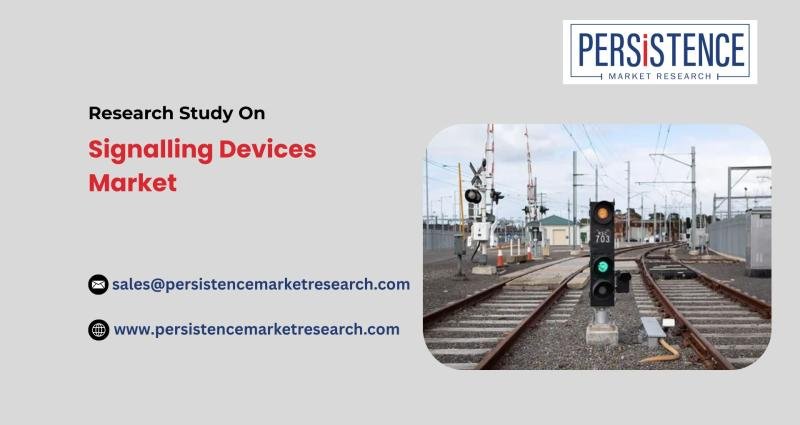The global signalling devices market is a vital segment in industrial and residential safety, designed to alert individuals about hazards or system failures through visual or audible signals. These devices are crucial for preventing accidents, enhancing workplace safety, and safeguarding physical assets. From fire alarm systems in homes to hazardous area signalling in oil rigs, signalling devices provide the first line of defense against risks such as fires, explosions, and equipment failures.
As of 2022, the global signalling devices market was valued at USD 3.3 billion, with a projected growth rate of 4.2% CAGR between 2022 and 2032, potentially reaching USD 4.9 billion by the end of the forecast period. This growth is fueled by the rising demand for enhanced safety across various sectors, stringent safety regulations, and the increasing focus on automation and industrial safety standards.
Among the major segments, the audible signalling devices category is expected to maintain its lead, with a 4.1% CAGR. This dominance can be attributed to the critical role these devices play in alerting workers in environments where visual contact is limited. The demand for visual signalling devices is also rising but remains secondary compared to audible devices.
Get a Sample Copy of Research Report (Use Corporate Mail id for Quick Response):
https://www.persistencemarketresearch.com/samples/33503
In terms of geography, China is expected to maintain its dominance in the global market. The nation is projected to reach a market value of around USD 1.2 billion by 2032, driven by the expansion of industries like oil and gas and mining, where signalling devices are crucial for ensuring worker safety in hazardous environments. Similarly, the United States and Japan are poised to see steady market growth, with projected CAGRs of 3.0% and 4.4%, respectively, due to their emphasis on workplace safety and advanced infrastructure development.
✅ Key Highlights from the Report:
➤ Global signalling devices market size in 2022: USD 3.3 billion.
➤ The market is expected to grow at a 4.2% CAGR from 2022 to 2032.
➤ Audible signalling devices remain the dominant segment in the market.
➤ China is projected to lead the market, with a significant share in hazardous area signalling applications.
➤ Fire & industrial signalling is the largest application segment, with a 4.0% CAGR forecast.
➤ Key players in the market include Siemens, Honeywell, and E2S Warning Signals.
✅ Market Segmentation
The global signalling devices market is divided into several segments based on type, application, and end-user industries. The primary product categories in the market are audible and visual signalling devices. Audible signalling devices, such as sirens, alarm horns, and alarm sirens, are widely adopted across industries to warn of immediate dangers in environments where visual contact with signals is impossible or difficult. These devices are popular in industrial plants, power generation facilities, and manufacturing units where high noise levels may obscure visual signals.
Visual signalling devices, including beacons, strobe lights, and tower lights, are used in conjunction with audible devices to provide a more comprehensive alert system. Combined audible and visual signalling devices, often known as dual signaling devices, are gaining traction due to their enhanced effectiveness. These devices are particularly useful in environments where multiple hazards need to be communicated simultaneously, ensuring that workers are alerted to issues, even in noisy or visually obstructed areas.
The applications for these signalling devices are also diverse, with fire and industrial signalling being the leading category. This segment is driven by the need to prevent fire accidents in industrial plants, chemical facilities, and warehouses. The rising frequency of fire accidents worldwide has increased the demand for reliable and rapid warning systems to ensure the safety of employees and equipment. Additionally, hazardous area signalling devices are increasingly used in industries such as oil & gas, where explosive environments require specific safety measures.
✅ Regional Insights
The market for signalling devices is geographically diverse, with significant demand in both developed and emerging economies. North America and Europe have a strong market presence due to advanced industrial infrastructure, robust regulatory frameworks, and increasing safety standards. The United States, for instance, has witnessed an uptick in the adoption of signalling devices in various sectors like oil & gas, manufacturing, and utilities, which are highly prone to accidents. This is particularly due to the enforcement of safety regulations and the rising number of fire incidents, further pushing the need for early warning systems.
Meanwhile, Asia-Pacific is expected to witness the fastest growth in the signalling devices market. The region’s industrialization, particularly in China and India, has led to an increased need for signalling devices in manufacturing, construction, and mining sectors. The robust growth of the oil & gas and mining industries in China, in particular, is driving demand for hazardous area signalling devices. Furthermore, rapid urbanization and the increase in infrastructure development projects across India and Southeast Asia are boosting the adoption of fire alarm systems and industrial safety equipment.
✅ Market Drivers
The growth of the global signalling devices market is driven by several key factors, starting with the increasing focus on improving safety standards across various industries. Government regulations and workplace safety norms are becoming stricter globally, particularly in sectors such as manufacturing, oil & gas, and utilities. This has led to the increased installation of signalling devices to ensure compliance with these standards. The escalating number of workplace accidents, particularly in industries with hazardous environments, has also made safety devices a necessity rather than a luxury.
Another key driver is the rise in automation and the use of smart safety solutions. Many modern industrial plants now use automated systems that integrate signalling devices for real-time alerts, ensuring faster response times in the event of a malfunction or emergency. This transition towards automated safety systems is expected to continue driving market growth, especially as more businesses invest in Industry 4.0 solutions.
Moreover, the decreasing cost of signalling devices due to advancements in manufacturing technologies has made these devices more affordable. The widespread adoption of LED technology, which has enhanced the efficiency and durability of signalling devices, is also expected to fuel market growth, as these solutions are more cost-effective and energy-efficient.
✅ Market Restraints
While the signalling devices market is poised for growth, several challenges could impact its expansion. One of the main restraints is the high installation and maintenance costs associated with these devices, particularly in high-risk sectors like oil & gas, where explosion-proof signalling devices are required. These specialized devices tend to be more expensive, which could limit their adoption in smaller businesses or in emerging economies with lower purchasing power.
Furthermore, there is a need for specialized knowledge and expertise when installing and maintaining these systems, particularly in hazardous environments. Inadequate training of personnel could result in improper installation, which might undermine the effectiveness of the signalling devices, posing a risk to worker safety.
Lastly, the market faces challenges in terms of regulatory compliance. Different regions have varying standards for signalling devices, and manufacturers must ensure that their products meet the specific regulatory requirements of each country or region they operate in. This can result in increased costs and delays in product development, affecting the speed at which new technologies reach the market.
✅ Market Opportunities
There are several growth opportunities for players in the signalling devices market, particularly with the ongoing advancements in technology. The demand for combined audible and visual signalling devices is expected to continue rising, as these solutions offer a more comprehensive approach to safety. This provides an opportunity for manufacturers to innovate and offer multi-functional devices that can cater to diverse industrial applications.
Another significant opportunity lies in the growing adoption of wireless and IoT-enabled signalling devices. These smart systems can communicate with central control units, providing real-time data and alerts. This is particularly relevant in industries where equipment uptime is critical, such as in manufacturing and energy production. The ability to monitor signalling devices remotely and receive alerts instantly can significantly improve operational efficiency and safety.
Additionally, there is a growing market for explosion-proof and flameproof signalling devices, especially in hazardous environments such as chemical plants, oil rigs, and mines. Manufacturers that specialize in these niche products are expected to see steady demand from the oil & gas sector and other industries operating in dangerous environments.
✅ Frequently Asked Questions (FAQs)
➤ How Big is the Market?
➤ Who are the Key Players in the Global Market for Signalling Devices?
➤ What is the Projected Growth Rate of the Market?
➤ What is the Market Forecast for 2032?
➤ Which Region is Estimated to Dominate the Industry Through the Forecast Period?
✅ Company Insights
✦ Siemens AG
✦ Honeywell International, Inc.
✦ ABB Ltd.
✦ Rockwell Automation, Inc.
✦ E2S Warning Signals
✦ Emerson Electric Co.
✦ Patlite Corporation
✦ Thales Group
✦ R. Stahl AG
✦ Eaton Corporation PLC
✅ Recent Developments
■ In January 2023, Siemens expanded its fire detection portfolio with the launch of two novel aspirating smoke detectors, FDA261 and FDA262, designed for large critical infrastructure areas.
■ In June 2022, Thales introduced the VisioLoc geolocalisation system, enhancing real-time location tracking for land forces in various environments.
Conclusion
The demand for both audible and visual signalling devices will continue to rise, fueled by the expansion of key industries such as oil & gas, manufacturing, and transportation. The shift towards combined signalling devices and the adoption of LED technology are likely to further propel market growth. Moreover, the growing emphasis on fire safety and workplace hazard prevention will create significant opportunities for companies operating in this sector.
Contact Us:
Persistence Market Research
G04 Golden Mile House, Clayponds Lane
Brentford, London, TW8 0GU UK
USA Phone: +1 646-878-6329
UK Phone: +44 203-837-5656
Email: sales@persistencemarketresearch.com
Web: https://www.persistencemarketresearch.com
About Persistence Market Research:
At Persistence Market Research, we specialize in creating research studies that serve as strategic tools for driving business growth. Established as a proprietary firm in 2012, we have evolved into a registered company in England and Wales in 2023 under the name Persistence Research & Consultancy Services Ltd. With a solid foundation, we have completed over 3600 custom and syndicate market research projects, and delivered more than 2700 projects for other leading market research companies’ clients.
Our approach combines traditional market research methods with modern tools to offer comprehensive research solutions. With a decade of experience, we pride ourselves on deriving actionable insights from data to help businesses stay ahead of the competition. Our client base spans multinational corporations, leading consulting firms, investment funds, and government departments. A significant portion of our sales comes from repeat clients, a testament to the value and trust we’ve built over the years.
This release was published on openPR.


















